语言学精品课(胡壮麟版)ppt-01
- 格式:ppt
- 大小:335.00 KB
- 文档页数:21



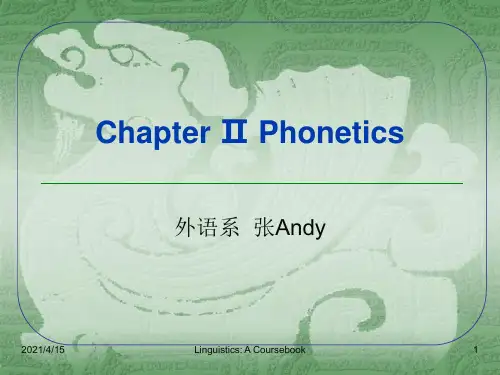


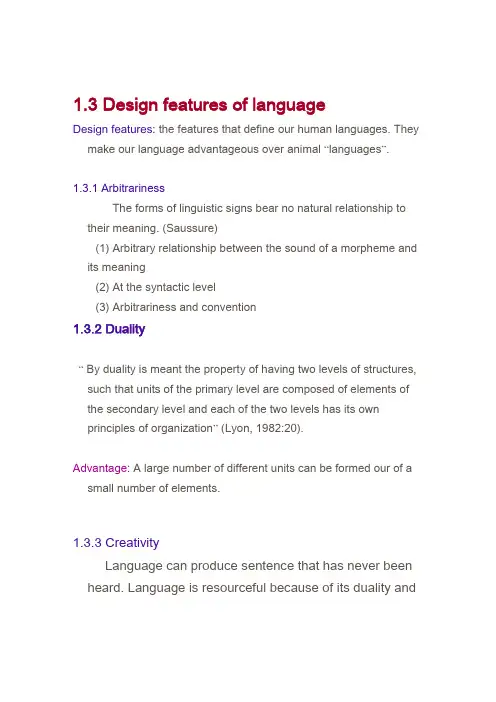
1.3 Design features of languageDesign features: the features that define our human languages. They make our language advantageous over animal “languages”.1.3.1 ArbitrarinessThe forms of linguistic signs bear no natural relationship to their meaning. (Saussure)(1) Arbitrary relationship between the sound of a morpheme andits meaning(2) At the syntactic level(3) Arbitrariness and convention1.3.2 Duality“ By duality is meant the property of having two levels of structures, such that units of the primary level are composed of elements of the secondary level and each of the two levels has its ownprinciples of organization” (Lyon, 1982:20).Advantage: A large number of different units can be formed our of a small number of elements.1.3.3 CreativityLanguage can produce sentence that has never been heard. Language is resourceful because of its duality andrecursiveness.1.3.4 DisplacementHuman languages enable their users to symbolize objects, events and concepts which are not present ( in time and space) at the moment of communication.Other design featuresCultural transmissionLanguage is passed down from generation to generation. Human being must be exposed to language environment.InterchangeabilityAny human being can be both a producer and receiver of the message.1.4 Origin of languageThe bow-wow theoryThe pooh-pooh theoryThe “yo-he-ho” theory1.5 Functions of language1.5.1 Informative1.5.2 Interpersonal function1.5.3 Performative1.5.4 Emotive function1.5.5 Phatic communion1.5.6 Recreational function1.5.7 Metalingual function1.6 What is linguistics?Linguistics is the scientific study of language.1.7 Main branches of linguistics1.7.1 PhoneticsPhonetics is the subfield of linguistics that studies speech sounds in human language.Major domains: Articulatory phonetics, Acoustic phonetics, Auditory phonetics1.7.2 Phonology-Phonology is the subfield of linguistics that studies the sound pattern of a language. -It deals with the rules governing the structure,distribution and sequencing of speech sounds and the shape of syllables.-Phonetics vs. PhonologyPhonetics is the study of speech sounds that the human voice is capable of creating whereas phonology is the study of a subset of those sounds that constitute language and meaning. The first focus on chaos while the second focuses on order.1.7.3 MorphologyMorphology is the subfield of linguistics that studies the internal structure of words and the relationships among words.1.7.4 SyntaxSyntax is the subfield of linguistics that studies the internal structure of sentences and the relationships among the internal parts.1.7.5 SemanticsSemantics is the subfield of linguistics that studies the nature of the meaning of individual words, and the meaning of wordsgrouped into phrases and sentences.1.7.6 PragmaticsPragmatics is the subfield of linguistics that studies the use of words, phrases and sentences in the actual context of discourse.1.8 Macrolinguistics1.8.1 PsycholinguisticsPsycholinguistics studies the relationship between language and mind. It also studies language development in the child, biological foundations of language and the relationship between language and cognition.1.8.2 SociolinguisticsSociolinguistics is the study of characteristics of language varieties, the characteristics of their functions, and thecharacteristics of their speakers.1.8.3 Anthropological linguisticsAnthropological linguistics is the study of the history and structure of formerly unwritten languages. They are concerned with the emergence and divergence of languages over thousands of years.1.8.4 Computational linguisticsComputational linguistics is an interdisciplinary field which centers around the use of computers to process or produce human language.1.9 Important distinctions in linguistics1.9.1 Descriptive vs. prescriptive-Descriptive (non-normative): to describe what people say. “… the linguist tries to discover and record the rules to which the members of a language-community actually conform and does not seek to impose upon them other rules, or norms, of correctness.” (Lyon, 1982:47)-Prescriptive: to prescribe how people should say. In the 18th century, the grammarians tried to lay down rules for the correct use oflanguage and settle the disputes over usage once and for all.1.9.2 Synchronic vs. diachronic-Synchronic linguistics is the study of a given language at a given period of time. E.g. “A Grammar of Modern Greek”-Diachronic linguistics is the study of the changes the language has experienced.1.9.3 Langue & parole (Saussure)-Langue is the abstract linguistic form or system shared by all the members of a speech community. It is a social product. It is a set of convention.-Parole is the actual or actualized language. It is the concrete use of the conventions or application of the rules.1.9.4 Competence and performance (Chomsky)-Competence refers to the ideal language speaker’s underlying knowledge about the system of rules.-Performance refers to the actual use of language by the speaker in concrete situation.1.9.5 Etic vs. Emic (Pike)Questions and ExercisesDo you think that onomatopoeia indicates a non-arbitrary relationship between form and meaning?Does the traffic light system have duality, why?Communication can take many forms, such as sign, speech, body language and facial expression. Do body language and facial expressionshare or lack the distinctive properties of human language?Can you mention some typical expressions of phatic communion in Chinese?。
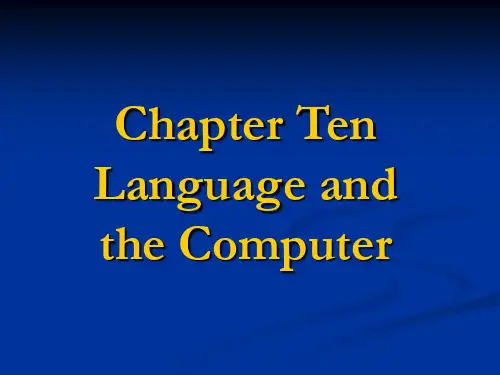

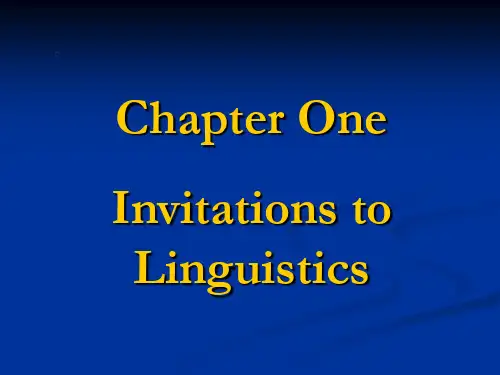
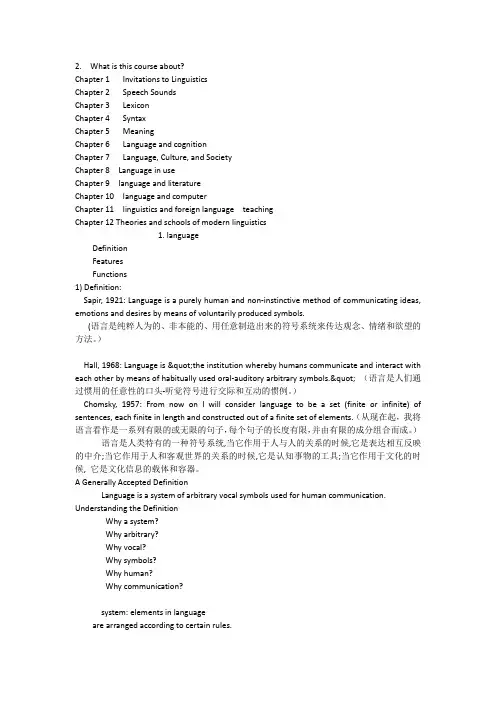
2. What is this course about?Chapter 1 Invitations to LinguisticsChapter 2 Speech SoundsChapter 3 LexiconChapter 4 SyntaxChapter 5 MeaningChapter 6 Language and cognitionChapter 7 Language, Culture, and SocietyChapter 8 Language in useChapter 9 language and literatureChapter 10 language and computerChapter 11 linguistics and foreign language teachingChapter 12 Theories and schools of modern linguistics1. languageDefinitionFeaturesFunctions1) Definition:Sapir, 1921: Language is a purely human and non-instinctive method of communicating ideas, emotions and desires by means of voluntarily produced symbols.(语言是纯粹人为的、非本能的、用任意制造出来的符号系统来传达观念、情绪和欲望的方法。
)Hall, 1968: Language is "the institution whereby humans communicate and interact with each other by means of habitually used oral-auditory arbitrary symbols." (语言是人们通过惯用的任意性的口头-听觉符号进行交际和互动的惯例。
语言学教程胡壮麟(第四版)第1章第1章Invitations to Linguistics第一部分Design features of languageThe features that define our human languages can be called design features which can distinguish human language from any animal system of communication.1. ArbitrarinessArbitrariness, put forward by Saussure, means that the forms of linguistic signs have no natural relationship to their meanings. For example, there is no necessary relationship between the word monkey and the animal it symbolizes.However, there are different levels of arbitrariness:1) Arbitrary relationship between the sound of a morpheme and its meaning.Language is not entirely arbitrary, even with onomatopoeic words that sound like the sounds they describe, such as crash, bang in English.Totally different words are used to describe the sound. e.g. the dog barks bowwow in English but 汪汪汪in Chinese.Besides, some compound words are also not entirely arbitrary, such as photocopy.2) Arbitrariness at the syntactic level:Language is not arbitrary at the syntactic level. And there is a certain degree of correspondence between the sequence of clauses and the real happening. For example,He came in and sat down. He sat down and came in. He sat down after came in.3) Arbitrariness and conventionConvention means you have to say things in this way andyou can’t change the expression any other way. The link between a linguistic sign and its meaning is a matter of convention. Arbitrariness of language makes it potentially creative, and conventionality of language makes learn a language laborious.2. DualityDuality means that the property of having two levels of structures, such that units of the primary level are composed of elements of the secondary level and each of the two levels has its own principles of organization. The property of duality only exists in such a system, namely, with both elements and units.Many animals communicate with special calls, which have corresponding meanings. That is, the primary units have meanings but cannot be further divided into elements. For example, tens of thousands of words are formed out of a small set of sounds, around 40 in the case of the English language.3. CreativityCreativity means that language is resourceful because of its duality and its recursiveness, and refers to the feature that one is able to construct and understand an infinitely large number of sentences in his native language, including these that one has never heard before.①Because of duality, the speaker is able to combine the basic linguistic units to form an infinite set of sentences, most of which are never produced or heard.②Recursiveness, refers t o the rule which can be applied repeatedly without any definite limit. The recursive nature of language provides a theoretical basis for the possibility of creating endless sentences.E.g. He bought a book which was written by a teacher whotaught in a sch ool which…4. DisplacementDisplacement means that human languages enable their users to symbolize objects, events and concepts which are not present at the moment of conversation. We can talk about things that are not present, as easily as we do things present. In other words, we can refer to real and unreal things, things of the past, of the present, of the future.Displacement benefits human beings by giving us the power to handle generalizations and abstractions. Once we can talk about physically distant thing, we acquire the ability to understand concepts which denote “non-things”, such as truth and beauty. For example, I can refer to Confucius even though he has been dead for over 2550 years.第二部分Hu Zhuanglin, language has at least seven functions1. Phatic communion(寒暄功能)考过It refers to the social interaction of language. We always use such small, seemingly meaningless expressions to maintain a comfortable relationship between people without any factual content. Ritual exchanges about health or weather such as Good morning, God bless you often state the obvious. They indicate that a channel of communication is open if it should be needed.Different cultures have different topics of phatic communication. For example, Chinese people useThe informative function means language is the instrument of thought and people often feel they need to speak their thoughts aloud.And language serves for the expression of content, that is, of the speaker’s experience of the realThe emotive function is one of the most powerful uses of language, because it is crucial in changing the emotional status of an audience for or against someone or something. e.g. God, damn it,The interpersonal function means people can use language to establish and maintain their status in a society.For example, the ways in which people address others and refer to themselves indicate the various grades of interpersonal relations, such as Dear Sir, Dear Professor, yours.In addition, attached to the interpersonal function of language is its function of expressing identity. For example, the shouting of names or slogans at public meetings all signal who we are and whereThe performative function of language is primarily to change the social status of persons, as in marriage ceremonies, the sentencing of criminals, the blessing of children, the naming of a ship at a launching ceremony, and the cursing of enemies.The recreational function means people use language for the sheer joy of using it, such as a baby’s babbling or a chanter’s chanting.The metalingual function means language can be used to talk about itself. For example, I can use the word “book” to talk about a book.To organize any written text into a coherent whole, writers employ certain expressions to keep their readers informed aboutwhere they are and where they are going. This makes the language infinitely self-reflexive, that is, we human can talk about talk and think about thinking.第三部分Main branches of linguistics1. Phonetics(语音学)Phonetics studies speech sounds, including the production of speech, that is, how speech sounds are actually made, transmitted and received, the description and classification of speech sounds, words and connected speech, etc.2. Phonology(音系学)Phonology studies the rules governing the structure, distribution, and sequencing of speech sounds and the shape of syllables.3. Morphology(形态学)Morphology is concerned with the internal structure of words, it studies the minimal units of meaning – morphemes and word-formation processes.4. Syntax(句法学)Syntax studies the sentence structure of language. Specifically, it is the study of the rules governing the ways in which words, word groups and phrases are combined to form sentences in a language, or the study of the interrelationships between sentential elements.5. Semantics(语义学)Semantics studies the meaning of linguistic units, words and sentences in particular.6. Pragmatics(语用学)Pragmatics studies the intended meaning of a speaker and takes context into consideration.第四部分Important distinctions in linguistics 重要区别1. Descriptive vs. prescriptive(描写式和规定式)To say that linguistics is a descriptive science is to say that the linguist tries to discover and record the rules to which the members of a language-community actually conform and does not seek to impose upon them other rules, or norms, of correctness.Prescriptive linguistics aims to lay down rules for the correct use of language and settle the disputes over usage once and for all.For example, “Don’t say X.” is a prescriptive command; “People don’t say X.” is a descriptive statement. The distinction lies in prescribing how things ought to be and describing how things are. In the 18th century, all the main European languages were studied prescriptively. However, modern linguistics is mostly descriptive because the nature of linguistics as a science determines its preoccupation with description instead of prescription.E.g. A grammar of Ancient Chinese.Diachronic: The study of language as it changes through time is diachronic.E.g. From Old English to Standard English.In modern linguistics, synchronic study seems to enjoy priority over diachronic study. The reason is that unless the various state of a language are successfully studied it would be difficult to describe the changes that have taken place in its historical development.Saussure distinguished the linguistic competence of the speaker and the actual phenomena or data of linguistics aslangue and parole.①Langue refers to the abstract linguistic system shared by all the members of a speech community, and parole refers to the actual or actualized language, or the realization of language.②Langue is relative stable and systematic, parole is subject to personal and situational constraints;③Langue is not spoken by an individual, parole is always a naturally occurring event.What a linguist should do, according to Saussure, is to abstract langue from instances of parole, i.e. to discover the regularities governing all instances of parole and make them the subject of linguistics.the linguistic competence, and the actual use of language in concrete situations is called performance. Competence enables a speaker to produce and understand an indefinite number of sentences and to recognize grammatical mistakes and ambiguities.A speaker’s co mpetence is stable while his performance is often influenced by psychological and social factors. So a speaker’s performance doesn’t always match his supposed competence. Chomsky believes that linguists ought to study competence, rather than performance.C homsky’s competence-performance distinction is not exactly the same as, though similar to, Saussure’s langue-parole distinction.Langue is a social product and a set of conventions of a community, while competence is considered as a property of mind of each individual.Saussure looks at language more from a sociological orsociolinguistic point of view than Chomsky since the latter deals with his issues psychologically or psycholinguistically.。
第1章Invitations to Linguistics第一部分Design features of languageThe features that define our human languages can be called design features which can distinguish human language from any animal system of communication.1. ArbitrarinessArbitrariness, put forward by Saussure, means that the forms of linguistic signs have no natural relationship to their meanings. For example, there is no necessary relationship between the word monkey and the animal it symbolizes.However, there are different levels of arbitrariness:1) Arbitrary relationship between the sound of a morpheme and its meaning.Language is not entirely arbitrary, even with onomatopoeic words that sound like the sounds they describe, such as crash, bang in English.Totally different words are used to describe the sound. e.g. the dog barks bowwow in English but 汪汪汪in Chinese.Besides, some compound words are also not entirely arbitrary, such as photocopy.2) Arbitrariness at the syntactic level:Language is not arbitrary at the syntactic level. And there is a certain degree of correspondence between the sequence of clauses and the real happening. For example,He came in and sat down. He sat down and came in. He sat down after came in.3) Arbitrariness and conventionConvention means you have to say things in this way and you can’t change the expression any other way. The link between a linguistic sign and its meaning is a matter of convention. Arbitrariness of language makes it potentially creative, and conventionality of language makes learn a language laborious.2. DualityDuality means that the property of having two levels of structures, such that units of the primary level are composed of elements of the secondary level and each of the two levels has its own principles of organization. The property of duality only exists in such a system, namely, with both elements and units.Many animals communicate with special calls, which have corresponding meanings. That is, the primary units have meanings but cannot be further divided into elements. For example, tens of thousands of words are formed out of a small set of sounds, around 40 in the case of the English language.3. CreativityCreativity means that language is resourceful because of its duality and its recursiveness, and refers to the feature that one is able to construct and understand an infinitely large number of sentences in his native language, including these that one has never heard before.①Because of duality, the speaker is able to combine the basic linguistic units to form an infinite set of sentences, most of which are never produced or heard.②Recursiveness, refers to the rule which can be applied repeatedly without any definite limit. The recursive nature of language provides a theoretical basis for the possibility of creating endless sentences.E.g. He bought a book which was written by a teacher who taught in a school which…4. DisplacementDisplacement means that human languages enable their users to symbolize objects, events and concepts which are not present at the moment of conversation. We can talk about things that are not present, as easily as we do things present. In other words, we can refer to real and unreal things, things of the past, of the present, of the future.Displacement benefits human beings by giving us the power to handle generalizations and abstractions. Once we can talk about physically distant thing, we acquire the ability to understand concepts which denote “non-things”, such as truth and beauty. For example, I can refer to Confucius even though he has been dead for over 2550 years.第二部分Hu Zhuanglin, language has at least seven functions1. Phatic communion(寒暄功能)考过It refers to the social interaction of language. We always use such small, seemingly meaningless expressions to maintain a comfortable relationship between people without any factual content. Ritual exchanges about health or weather such as Good morning, God bless you often state the obvious. They indicate that a channel of communication is open if it should be needed.Different cultures have different topics of phatic communication. For example, Chinese people useThe informative function means language is the instrument of thought and people often feel they need to speak their thoughts aloud.And language serves for the expression of content, that is, of the speaker’s experience of the realThe emotive function is one of the most powerful uses of language, because it is crucial in changing the emotional status of an audience for or against someone or something. e.g. God, damn it,The interpersonal function means people can use language to establish and maintain their status in a society.For example, the ways in which people address others and refer to themselves indicate the various grades of interpersonal relations, such as Dear Sir, Dear Professor, yours.In addition, attached to the interpersonal function of language is its function of expressing identity. For example, the shouting of names or slogans at public meetings all signal who we are and whereThe performative function of language is primarily to change the social status of persons, as in marriage ceremonies, the sentencing of criminals, the blessing of children, the naming of a ship at a launching ceremony, and the cursing of enemies.The recreational function means people use language for the sheer joy of using it, such as a baby’s babbling or a chanter’s chanting.The metalingual function means language can be used to talk about itself. For example, I can use the word “book” to talk about a book.To organize any written text into a coherent whole, writers employ certain expressions to keep their readers informed about where they are and where they are going. This makes the language infinitely self-reflexive, that is, we human can talk about talk and think about thinking.第三部分Main branches of linguistics1. Phonetics(语音学)Phonetics studies speech sounds, including the production of speech, that is, how speech sounds are actually made, transmitted and received, the description and classification of speech sounds, words and connected speech, etc.2. Phonology(音系学)Phonology studies the rules governing the structure, distribution, and sequencing of speech sounds and the shape of syllables.3. Morphology(形态学)Morphology is concerned with the internal structure of words, it studies the minimal units of meaning – morphemes and word-formation processes.4. Syntax(句法学)Syntax studies the sentence structure of language. Specifically, it is the study of the rules governing the ways in which words, word groups and phrases are combined to form sentences in a language, or the study of the interrelationships between sentential elements.5. Semantics(语义学)Semantics studies the meaning of linguistic units, words and sentences in particular.6. Pragmatics(语用学)Pragmatics studies the intended meaning of a speaker and takes context into consideration.第四部分Important distinctions in linguistics 重要区别1. Descriptive vs. prescriptive(描写式和规定式)To say that linguistics is a descriptive science is to say that the linguist tries to discover and record the rules to which the members of a language-community actually conform and does not seek to impose upon them other rules, or norms, of correctness.Prescriptive linguistics aims to lay down rules for the correct use of language and settle the disputes over usage once and for all.For example, “Don’t say X.” is a prescriptive command; “People don’t say X.” is a descriptive statement. The distinction lies in prescribing how things ought to be and describing how things are. In the 18th century, all the main European languages were studied prescriptively. However, modern linguistics is mostly descriptive because the nature of linguistics as a science determines its preoccupation with description instead of prescription.E.g. A grammar of Ancient Chinese.Diachronic: The study of language as it changes through time is diachronic.E.g. From Old English to Standard English.In modern linguistics, synchronic study seems to enjoy priority over diachronic study. The reason is that unless the various state of a language are successfully studied it would be difficult to describe the changes that have taken place in its historical development.Saussure distinguished the linguistic competence of the speaker and the actual phenomena or data of linguistics as langue and parole.①Langue refers to the abstract linguistic system shared by all the members of a speech community, and parole refers to the actual or actualized language, or the realization of language.②Langue is relative stable and systematic, parole is subject to personal and situational constraints;③Langue is not spoken by an individual, parole is always a naturally occurring event.What a linguist should do, according to Saussure, is to abstract langue from instances of parole, i.e. to discover the regularities governing all instances of parole and make them the subject of linguistics.the linguistic competence, and the actual use of language in concrete situations is called performance. Competence enables a speaker to produce and understand an indefinite number of sentences and to recognize grammatical mistakes and ambiguities.A speaker’s competence is stable while his performance is often influenced by psychological and social factors. So a speaker’s performance doesn’t always match his supposed competence. Chomsky believes that linguists ought to study competence, rather than performance.Chomsky’s competence-performance distinction is not exactly the same as, though similar to, Saussure’s langue-parole distinction.Langue is a social product and a set of conventions of a community, while competence is considered as a property of mind of each individual.Saussure looks at language more from a sociological or sociolinguistic point of view than Chomsky since the latter deals with his issues psychologically or psycholinguistically.。